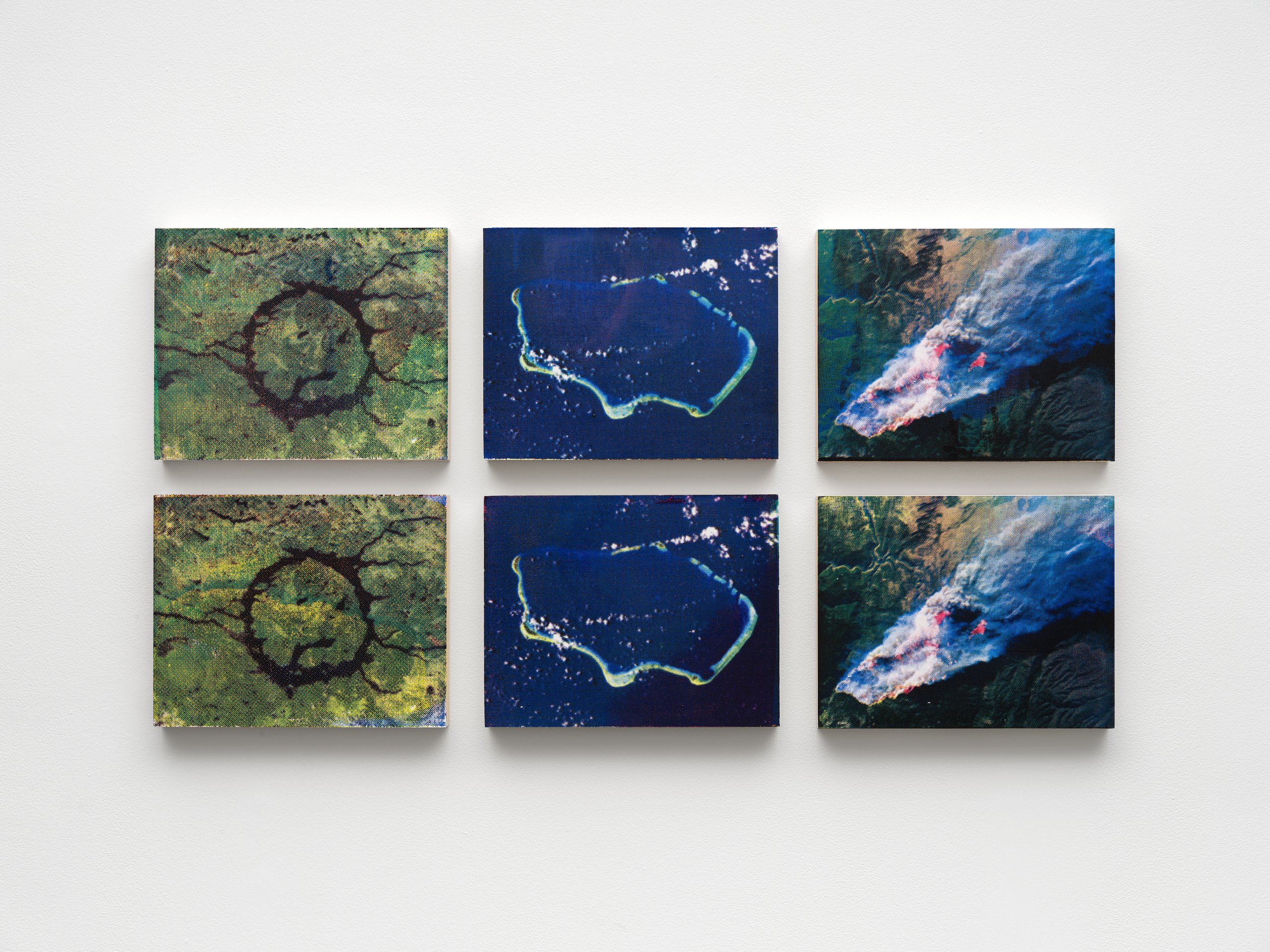The gallery is open 11am-5pm Thursday-Sunday and by appointment •
The gallery is open 11am-5pm Thursday-Sunday and by appointment •
Don Edler:
A Nightmare on the Brains of the Living
Opening reception Sunday September 17, 5-8pm
Exhibition on view September 17 - October 29
PRESS: Contemporary Art Library | Hyperallergic
Hunter Shaw Fine Art is pleased to present A Nightmare on the Brains of the Living, the gallery’s third solo exhibition with Los Angeles based artist Don Edler. The works on view constitute the latest chapter in Edler’s ongoing critical examination of the interrelationships between technology, cultural production and Western hegemony. Edler’s multidisciplinary approach articulates a nuanced visual history, illustrating a complex narrative of industrial society, its past and likely future. The artist conveys this story in a recent series of unique, CMYK silk screen prints on panel utilizing appropriated images from Western art history and mass media. Through a focused selection of source material, these works trace humanity’s Promethean impulses from the domestication of fire, to the age of peak oil and climate collapse. Edler expresses his views on the research and themes that guide this work through his speculative essay Prometheus and our Pyrophilic Anthropocene which will be available in the gallery.
In Greek mythology, Prometheus was a titan who stole fire from the Olympian gods, and gifted it to humanity in the form of knowledge, laying the groundwork for the development of technical civilization. For this transgression, Zeus, the king of the gods, punished Prometheus with eternal torture wherein Prometheus is bound to a rock and has his liver perpetually eaten by an eagle. Within the Western classical tradition, Prometheus has come to represent the perils and unintended consequences of the human quest for technology and scientific knowledge. One way to look at this myth is through its ideological subtexts, such as the embrace of hierarchy and the techno-colonial savior. The story reinforces the notion that people who may lack certain technologies are in need of technical salvation, and that it is the duty of a “higher” arbiter of knowledge to provide it to them. It should perhaps come as no surprise that an ideological construct that prioritizes epistemological and technological expansion is readily apparent in and emerges from the foundational mythology of Western civilization.1
In the present body of work, Edler engages the myth of Prometheus as a framework to illuminate the ways in which humanity’s pyrophilic (fire-loving) tendencies have advanced a ruthless and exploitative technological worldview with devastating repercussions for our planet and its inhabitants. In particular, Edler highlights the relationship between empire-building and increased energy consumption. Across the series we see early 20th century postcards advertising the oil fields of Los Angeles, alongside apocalyptic images of the Kuwait oil fires from almost a century later. In the former, a billowing spire of noxious smoke intends to entice prospective land owners with the bounty and fortunes to be made on the new frontiers of “black gold,” while the latter captures the catastrophic realities of militarized conflict over the control of valuable energy resources. The net result of this trajectory is clear: fire begets fire, and scorched Earth is all that remains.
Scattered across the gallery floor are several human and Homo erectus skulls coated in petroleum-based wax. Accompanying this boneyard is a free-standing vertical plank bearing a low-relief image of a guillotine. On one hand, these objects explicitly allude to the Reign of Terror of the French Revolution, while simultaneously, the tableaux also recalls the promethean “Dawn of Man'' sequence at the beginning of Stanley Kubrick's 2001: A Space Odyssey. In this chapter of the film, an otherworldly monolith appears to a group of hominins, sparking within them an understanding of technology and a bellicose lust for domination. While these symbolic associations are striking, Edler’s paraffin-coated Homo erectus skulls also refer to the probable real-life origin of human pyrophilia.
According to the pyrophilic primate hypothesis2 first introduced by anthropologist Christopher H. Parker, learning to control fire may have been one of, if not the first, steps in human technical development and subsequent domination of the so-called natural world. The theory argues that shifts in climate around 3 million years ago reshaped early hominin habitats exposing our ancestors to more frequent and more intense wildfires, reshaping their relationship to the environment and its resources. As foraging in the aftermath of wildfires eventually led to the controlled use of fire for cooking, we gained access to cheaper calories, giving our minds and brains the excess energy to evolve and develop our complex cognitive abilities. Over time, these abilities enabled our capacity to produce advanced tools such as the Acheulean “hand axe,” believed to have been created by Homo erectus 1.7 million - 100,000 years ago. Recent research by experimental archaeologist Dietrich Stout shows the highly sophisticated cognitive demands of ancient tool making, and Stout points out that his research “adds to evidence of the importance of these brain systems for stone tool making, and also shows how tool making may have shaped the brain evolutionarily.”3 In other words, just as the human mind shaped the development of these tools, the tools appear to have shaped the development of the human mind in return.
Throughout the exhibition, Edler grapples with the cumulative weight of this legacy, revealing the deeply entangled relationship between human evolution and energy technology which has reached its crux in the late stages of industrial society. As we face the challenges of a future built on the fallout of the past, it is important to consider the destructive patterns that we have repeated along the way. We learned how to burn things for energy 1-2 million years ago, and despite our substantial technical and social development, we are still burning things for energy today in the form of fossil fuels. Edler urges us to recognize that aspects of what make us can also unmake us. Karl Marx, commenting on history and the memory of failed revolutions, writes: “Men make their own history, but they do not make it as they please; they do not make it under self-selected circumstances, but under circumstances existing already, given and transmitted from the past. The tradition of all dead generations weighs like a nightmare on the brains of the living.”4
Don Edler was born in Bremen, Germany and immigrated as a child to South Florida. He received an MFA in Design|Media Arts from UCLA, as well as an MFA in Studio Art from New York University. Edler received a BFA in Sculpture from University of Florida, Gainesville FL, and also attended Skowhegan School of Painting and Sculpture, Madison ME. Recent solo exhibitions include Tablets 2017-2021, B___ (B Space), Los Angeles (2021); Devil You Know, Hunter Shaw Fine Art, Los Angeles (2021); Two Minutes To Midnight, Hunter Shaw Fine Art, Los Angeles (2019); 6871 California Ave, Five Car Garage, Los Angeles (2018); The Father The Sun and The Holy Road, San Diego Art Institute, San Diego, CA (2016). Selected group exhibitions include We Are They: Glitch Ecology and the Thickness of Now, Honor Fraser, Los Angeles (2023); Local Objects, International Objects, Brooklyn (2023); Changwon Sculpture Biennale: Wave-Particle Duality, Changwon City, Korea (2022); Poetic Realities organized by Lauren Lee McCarthy, New Wight Gallery, UCLA (2022); Deep Time with Cara Chan, Hunter Shaw Fine Art, Los Angeles (2022); Ecoshamanism curated by Ian James, Leroy’s Happy Place, Los Angeles (2018). Edler lives and works in Los Angeles and is an adjunct professor at the USC School of Cinematic Arts, Media Arts + Practice (MAP) program where he lectures on the history of optics, advanced camera systems and cultural production under capitalism.
1 Edler, Don. “Prometheus and Our Pyrophylic Anthropocene” 2022-23.
2 Parker, Christopher, Earl R. Keefe, Nicole M. Herzog, James F. O’connell, and Kristen Hawkes. “The Pyrophilic Primate Hypothesis.” Evolutionary Anthropology: Issues, News, and Reviews 25, no. 2 (2016): 54–63. https://doi.org/10.1002/evan.21475.
3 Stout, Dietrich, Erin Hecht, Nada Khreisheh, Bruce Bradley, and Thierry Chaminade. “Cognitive Demands of Lower Paleolithic Toolmaking.” PLOS ONE 10, no. 4 (April 15, 2015): e0121804. https://doi.org/10.1371/journal.pone.0121804.
4 Marx, Karl. 18th Brumaire of Louis Bonaparte. 1852. https://www.marxists.org/archive/marx/works/1852/18th-brumaire/ch01.htm.



































